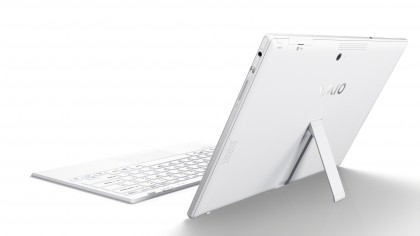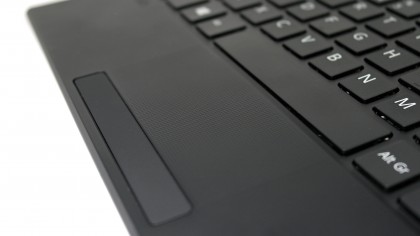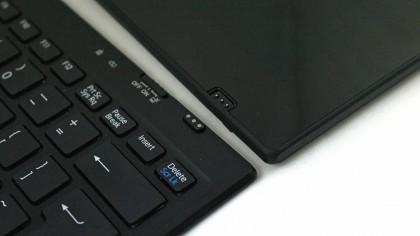Why you can trust TechRadar
Benchmarks
Cinebench 11.5: OpenGL: 8.14fps CPU: 1.21pts
Battery Eater Pro: 2h 31m
We knew going into our tests that the processor on the Sony VAIO Tap 11 was going to be fairly light on CPU performance, thanks to its low-power 4210Y Haswell chip. And yes, sure enough, we're not exactly talking about a high-end chip here despite the Core i5 branding.
The Cinebench score of 1.21 is about double what Intel's current Atom chips in the likes of the Lenovo Miix 10 get, but only half of what the Haswell laptop chip in the Samsung ATIV Book 9 gets, and that's not a high-end machine by any means – it's intended to be a very portable, slim Ultrabook.
It's a similar story for the graphics, with the Intel HD 4200 GPU in the VAIO Tap 11 scoring just over half of what the Intel HD 4400 in the Samsung ATIV Book 9 achieves in the OpenGL tests (which is lower again than what the Intel HD 5000 in the Apple MacBook Air gives you).

Unfortunately, we had real problems running our full range of benchmarks on the VAIO Tap 11, with 3D Mark and PC Mark simply throwing up an error no matter what we tried. We didn't have problems with any other software refusing to run, but it's possible that could affect other apps, so be aware.
Still, the raw performance figures were to be expected really. Certainly, it's faster and more capable than the Atom-powered tablets we've seen, but we feel like you'd have to really, really want a tablet form factor that's thinner than the Surface Pro 2 to make it worthwhile.
In use, the VAIO Tap 11 is broadly fine. It does suffer from a few performance hiccups in spots (most annoying is when the popups from annoying pre-loaded bloatware cause slow-down in the useful thing you're trying to do), but nothing dramatic. You do get times when its speed seems to get in the way (installing Windows updates takes ages, for example), but it's not like the slowness of the Atom-based machines, where it takes an age for even a .ZIP file to extract.
Fan club
One downside to the extra power, though, is that when you do something more intensive with the VAIO Tap 11, its fans kick in quickly, and they're not quiet. The hot air is pretty noticeable, too, but it's pushed out of the top of the machine so is unlikely to cause any overheated laps.
When you're pottering about in the OS or doing some light web browsing, it's mostly silent, but you'll be surprised at the times it starts to kick off – even just the Bing app will get it going. When it's sitting on your desk like a laptop, it doesn't seem that odd, but when you're holding it like a tablet, it's alarming.
Unfortunately, battery life is another fairly weak spot. Lasting for two and half hours in our intensive tests isn't absolutely terrible, but is lower than we tend to expect from Ultrabooks, which have higher-powered processors. We realise that the high-resolution screen and small size mean that battery life is a difficult balance for a machine like this, but the reality is still less than we'd like. For very light tasks, you'll get more suitable battery life, but compared to the almost five hours of Sony's own VAIO Duo 13, the battery life of the VAIO Tap 11 looks low.
In fact, we should point out that the Samsung ATIV Book 9 we mentioned earlier as being about twice as powerful also gets about twice the battery life…
Keyboard
The keyboard that comes with the VAIO Tap 11 is really quite good for something so thin. In terms of key size, it's excellent, with plenty of space for each key. We could type accurately, and really comfortably. There's a nice amount of resistance to the keys initially, and though the travel is short and they're a little dead when pressed, there's good feedback overall. There's little wobble or rattle either, at least to the letter keys – the keys on the edges do tend to rattle a bit, but you don't to use them much, so it wasn't a problem.
The trackpad is really interesting, though. The bumpy surface is actually quite pleasant to use, and gives a great amount of feedback to your fingers as to how far you've moved. You can still use a tap on it to click, which is good, because the little mouse button below is stiff and awkward. The sensitivity on the trackpad was too low for us out of the box, but that's easily fixed. The lack of a lip on the edge did mean that we activated some Windows 8 gestures accidentally more often than usual, though.

There is one noticeable issue with the keyboard unit, however – it takes a second or so to wake up if you leave it alone for a couple of minutes. Stare off into space while typing, and your first letter will disappear, or nothing will happen with the trackpad when you try to move the pointer. It's annoying when typing, and though it's not the end of the world, it's hardly ideal.
The whole setup with the keyboard is weird, as well. The way it magnetically fits to the front as cover is all well and good, but it's very odd to give it no way of charging on its own. And the fact that the tablet has its own stand with the keyboard totally separate is sometimes useful as far as arranging yourself comfortably, but isn't always great for travelling. On a fold-out seat on a train or plane, you'll struggle for space compared to the traditional laptop design of the Samsung ATIV Smart PC, or a nice small laptop such as the Asus VivoBook S200.
The stylus is an interesting addition – it's certainly accurate and useful for artists, but it's handy for regular users too, since many things on-screen can be tiny, and if you don't have a useful surface to place the keyboard on, you're a bit stuck. That said, for long use, it's not the most ergonomic stylus – it's straight, smooth metal almost the whole way. A thicker, rubbery grip would be really useful. It looks smart this way, but a little more practicality wouldn't go amiss.
The screen is actually really nice, with loads of detail offered by the Full HD 1080p display. It's not the brightest, which can lead to issues with reflections, but it's colourful and offers brilliant viewing angles. You do have issues with many desktop apps opening up with tiny buttons and text, though – the stylus and trackpad can help here, and you can do some adjustments, but some software will just require squinting. It's less of a problem in touch-optimised apps, of course, so how big an issue it is for you will probably depend on what you use the tablet for most.

The speaker on the back is loud enough, despite facing away from you, but isn't massively high quality – you can hear it crushing some of the treble when things get busy. It's fine for most uses, but you'll notice the occasional harshness and shrillness.
